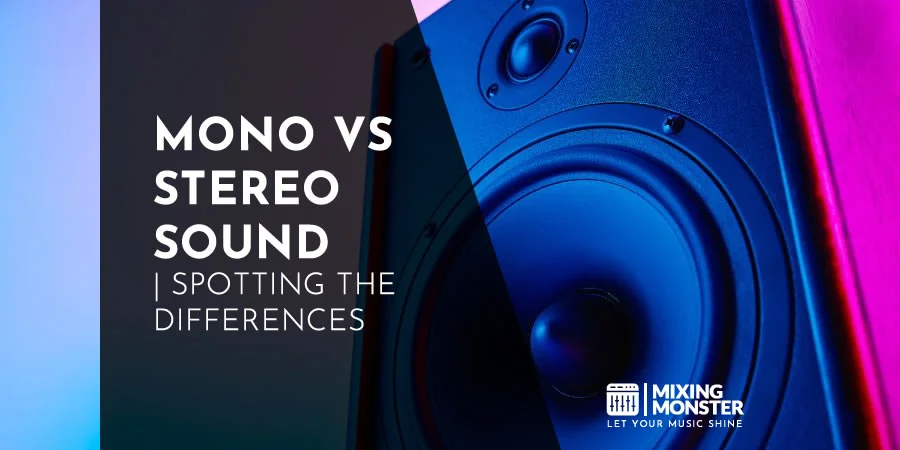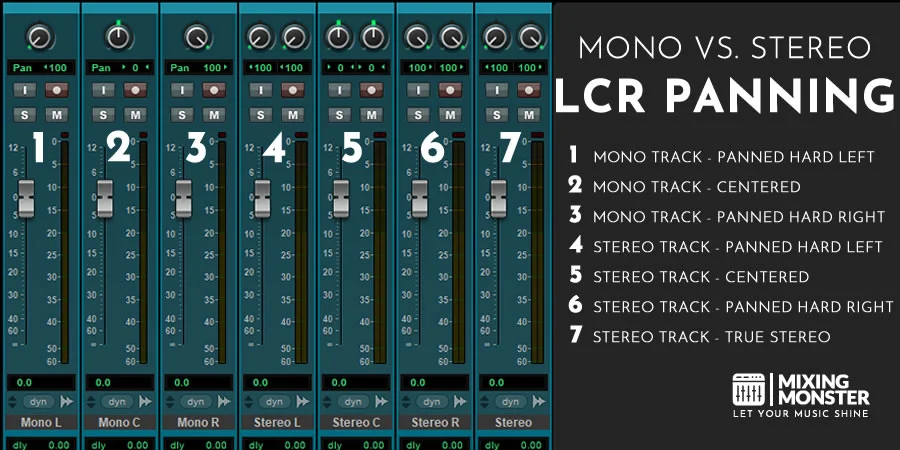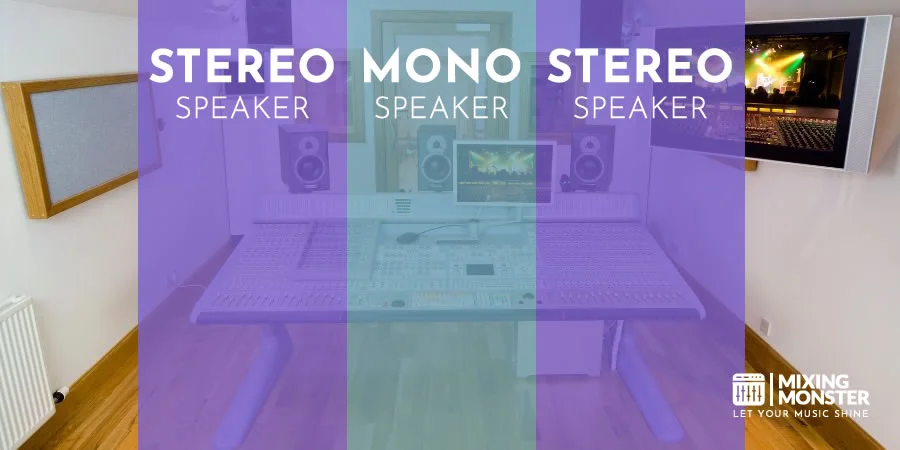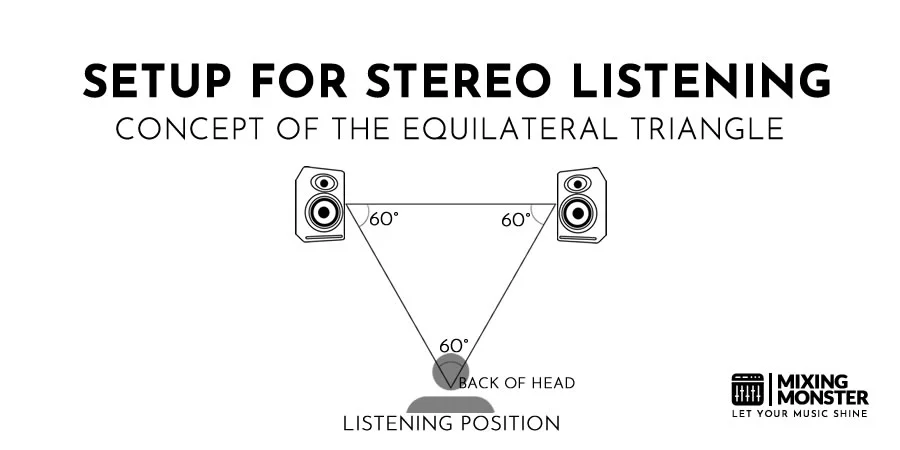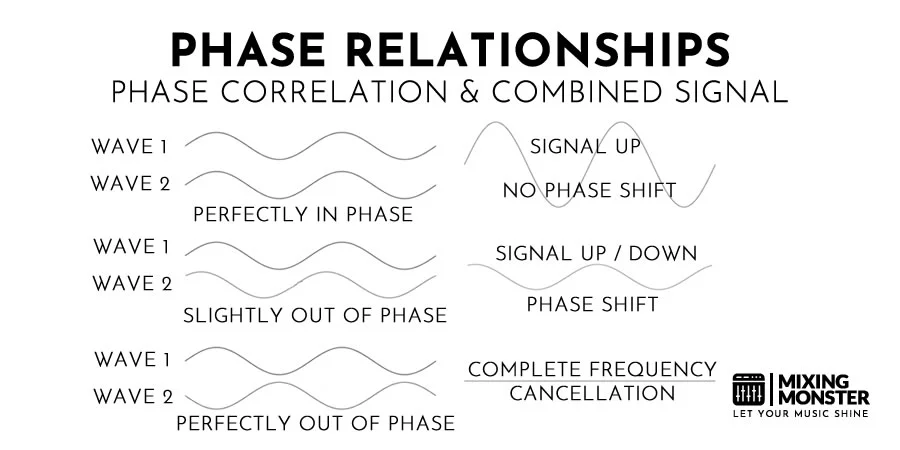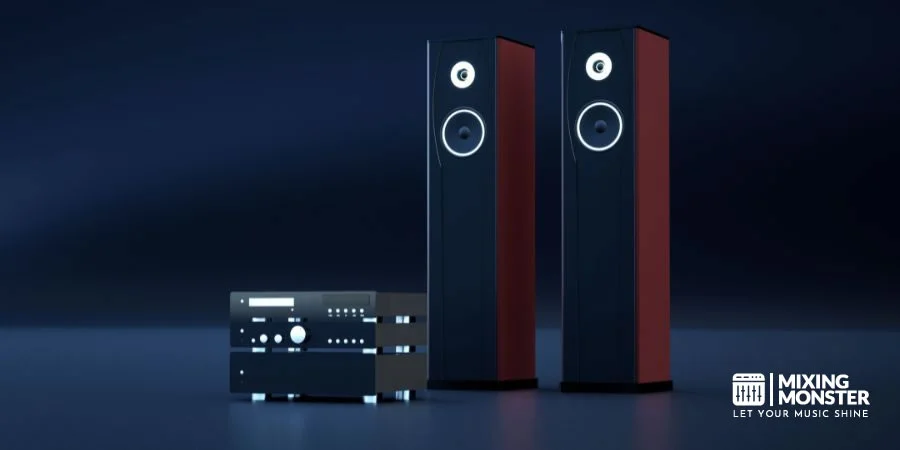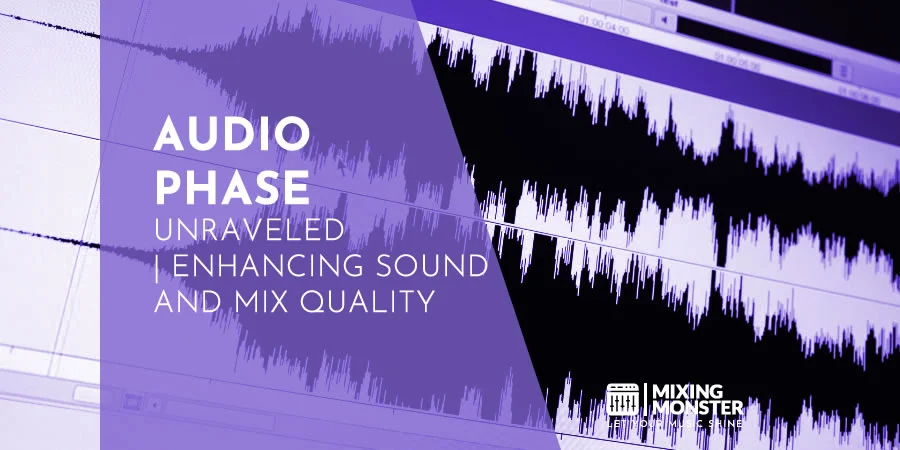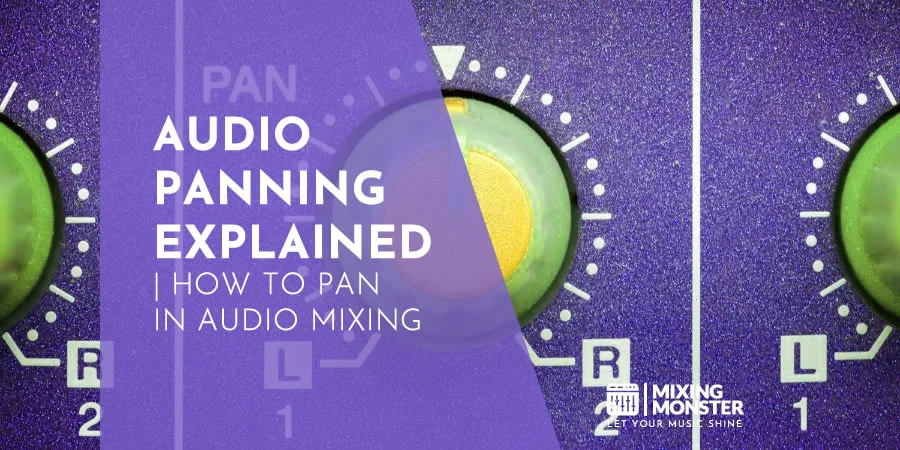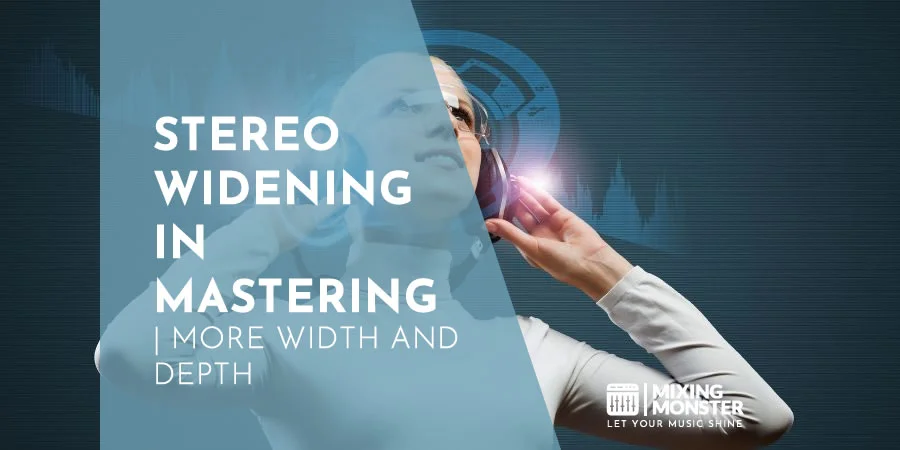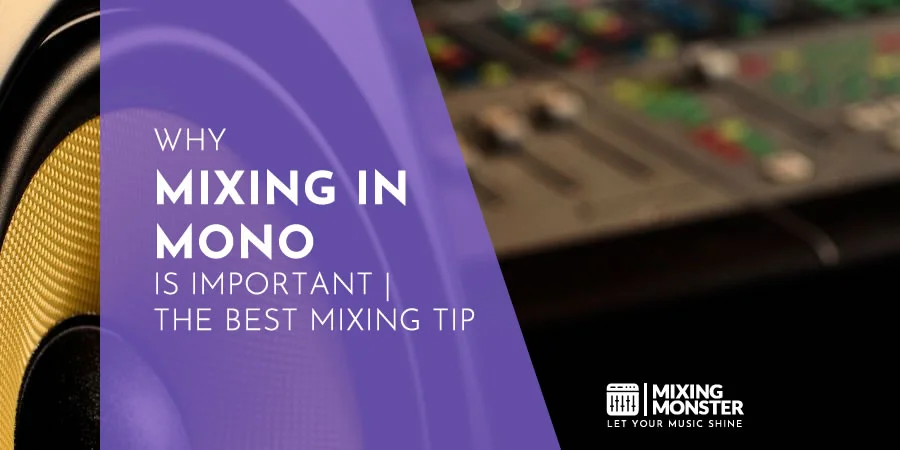Home > Blog > Music > Music Theory
Affiliate Disclaimer: We may earn a commission if you purchase through our links
In music production, mono vs stereo sound remains a topic of heated discussion. Whether you’re a seasoned audio engineer or a curious music enthusiast, understanding these two sound formats is essential in understanding the dimension they bring to our auditory experiences.
Mono vs stereo sound represents two fundamental ways of recording and reproducing sound. Mono, short for monophonic, refers to a sound system where all the sound signals are mixed and channeled through a single audio channel. Stereo, or stereophonic sound, uses two or more independent audio channels, creating a sense of dimension and spatial depth in the sound.
From the power of mono mixing to the technicalities of stereo width, polarity and phase, there are multiple practical implications in recording, mixing, and mastering. This exploration offers invaluable insights into the most fundamental aspects of sound in music production. Join us as we dissect the differences between mono and stereo sound, their benefits and challenges, guiding you to make informed decisions in your audio projects.
Table Of Contents
1. Mono Vs Stereo Sound Explained
2. What Is Mono Sound? The Basics Of Mono Sound
3. What Is Stereo Sound? Exploring Stereo Sound
4. Comparing Mono Vs Stereo Sound
5. Advantages And Disadvantages Of Mono Vs Stereo Sound
6. Mono Vs Stereo In The Real-World
7. Challenges And Solutions In Mono Vs Stereo Sound
8. Advanced Concepts In Stereo Sound
9. One Or Two Channels: Summarizing Mono Vs Stereo Sound
10. FAQ

1. Mono Vs Stereo Sound Explained
Mono Vs Stereo Sound In Music Production
The distinction between mono and stereo sound in music production is more than just technical jargon; it’s a fundamental aspect that shapes how we experience music.
Mono (monophonic) sound is audio recorded and played back through a single channel. This simplicity often leads to a direct and focused auditory experience.
On the other hand, stereo (stereophonic) sound uses two or more channels, offering a richer and more immersive soundscape. Using multiple channels in stereo allows for a spatial dimension in sound, giving listeners a sense of width and depth that mono cannot provide.
Here is an overview of simple mono and stereo tracks in a digital audio workstation (DAW) with different panning settings:
2. What Is Mono Sound? The Basics Of Mono Sound
Understanding Mono Sound
Mono sound, short for monophonic sound, is the earliest method of sound reproduction. It involves a single audio channel, meaning all sound elements are mixed into one channel.
This results in the same audio being played through all speakers, which is particularly advantageous in environments where sound coverage needs to be uniform.
Mono sound is characterized by its clarity and focus, making it ideal for speech and radio broadcasts where distinctness and intelligibility are key.
Mono Sound In Recording
In recording, mono sound offers a straightforward approach. Again, when capturing audio in mono, all sound sources are merged into a single track.
This can be particularly effective for capturing the raw essence of the performance, be it a vocal track, a guitar riff, or a drum beat. The simplicity of mono recording also means fewer complications in terms of mic placement and sound balancing.
The Power Of Mono Sound In Mixing And Mastering
When mixing and mastering, mono sound plays a crucial role. Mixing in mono can help identify and fix issues like frequency clashes and imbalances that might not be apparent in a stereo mix.
It also ensures that the track sounds good on mono playback systems, which is still relevant in various scenarios like radio broadcasting or public address systems.
Mono compatibility remains vital for professional audio production, ensuring the track maintains its integrity across different playback environments.
3. What Is Stereo Sound? Exploring Stereo Sound
The Nature Of Stereo Sound
Stereo sound, or stereophonic sound, is a method of sound reproduction that creates an illusion of multi-directional audible perspective. This is achieved using two or more independent audio channels by configuring two or more loudspeakers or stereo headphones.
The listener perceives a sound field with positional accuracy, giving an impression of depth and space. This spatial characteristic of stereo sound enriches the listening experience, especially in music, creating a more lifelike and immersive environment.
The optimal way to listen to stereo sound is shown below in the concept of the equilateral triangle:
Technicalities Of Stereo Width And Stereo Polarity
Stereo width and polarity are critical elements in creating adequate stereo sound. Stereo width is the perceived spatial extent between the left and right channels. It’s what gives stereo its ‘spread’ and can make the sound feel more immersive.
The manipulation of this width is a powerful tool in music production, allowing for creative placement of instruments within the stereo field. Stereo polarity, on the other hand, involves ensuring that the phase relationship between the left and right channels is coherent.
Incorrect polarity can lead to phase cancellation, where specific frequencies get lost, detracting from the fullness of the sound.
Stereo Sound In Modern Music Production
In modern music production, stereo sound is the norm. It allows producers and engineers to create a rich, layered, and detailed soundstage. From the subtle placement of background vocals to the expansive spread of a string section, stereo allows each element in a mix to occupy its own space.
This separation enhances clarity and adds realism and depth that cannot be achieved with mono sound alone. Stereo also opens up possibilities for creative effects like panning, where sounds can move across the stereo field, further enriching the listener’s experience.
4. Comparing Mono Vs Stereo Sound
Mono Vs Stereo Differences
The primary difference between mono and stereo sounds lies in their spatial representation. Mono sound, being single-channel, centers all audio elements, offering a focused but flat soundstage.
In contrast, stereo sound uses multiple channels (usually two), providing a sense of width and space. This spatial separation in stereo allows for a more realistic and immersive auditory experience, where sounds can be placed and heard from different directions.
Differences Between Mono Vs Stereo Sound
- Channel Usage:
Mono uses one channel; Stereo uses two or more. - Sound Placement:
Mono centers sound; Stereo allows for left-right placement. - Spatial Depth:
Mono is flat; Stereo creates a sense of depth and space. - Recording Complexity:
Mono is simpler to record; Stereo requires more precise mic placement and balancing. - Listener Experience:
Mono offers directness; Stereo provides an immersive experience. - Compatibility:
Mono works well on all systems; Stereo varies based on equipment and environment. - Mixing Approach:
Mono mixing focuses on balance and clarity; Stereo allows creative sound positioning and effects.
Mono Vs Stereo Sound: Impact On Listener Experience
The impact on the listener’s experience is significant when comparing mono and stereo sound. Mono’s direct and centered approach can be more effective for spoken words or when the listener focuses on the audio’s clarity and articulation.
Stereo, however, excels in creating an engaging and dynamic experience, especially in music, where the spatial distribution of instruments and vocals can evoke a more emotional response.
The choice between mono and stereo often depends on the intended listening environment and the nature of the audio content.

5. Advantages And Disadvantages Of Mono Vs Stereo Sound
Pros And Cons Of Mono Sound
Pros:
- Clarity And Focus:
Mono sound offers a clear and focused listening experience, making it ideal for speech and single-instrument recordings. - Compatibility:
Works well on all speakers and systems, ensuring consistent playback. - Simplicity In Mixing:
Mixing in mono is more straightforward, as it doesn’t involve balancing multiple channels in a stereo field.
Cons:
- Lack Of Depth:
Mono sound does not provide stereo sound’s spatial depth and immersive experience. - Limited Creative Options:
Offers fewer opportunities for creative sound placement and effects.
Pros And Cons Of Stereo Sound
Pros:
- Immersive Experience:
Stereo provides a more realistic and engaging listening experience, with sounds appearing to come from different directions. - Creative Flexibility:
Allows for innovative use of the sound space, enhancing the artistic expression in music. - Depth And Realism:
Adds depth and realism to recordings, making them feel more lifelike.
Cons:
- Complexity:
Requires more careful mixing and mastering to maintain balance and prevent phase issues. - Inconsistency Across Playback Systems:
Stereo sound can vary greatly depending on the listening environment and equipment.
Pros And Cons Of Mono Vs Stereo Sound
| Aspect | Mono Sound Pros | Mono Sound Cons | Stereo Sound Pros | Stereo Sound Cons |
| Clarity & Focus | High clarity, especially for vocals. | Limited spatial effects. | Rich spatial effects and immersion. | Complexity in balancing and phase issues. |
| Compatibility | Uniform sound on all playback systems. | May sound less dynamic on stereo systems. | Enhanced experience with stereo systems. | May be inconsistent on mono playback systems. |
| Mixing & Mastering | Easier to mix and master. | Less creative flexibility. | Greater creative flexibility in mixing. | Requires careful attention to prevent issues |
| Creative Possibilities | Suited for direct and focused audio. | Lacks spatial depth. | Allows dynamic positioning and effects. | Can be overwhelming if not well-balanced. |
6. Mono Vs Stereo In The Real-World
Uses Of Mono Vs Stereo Sound In Various Genres
The choice between mono and stereo sound depends mainly on the genre and the intended use.
Mono sound is often preferred in talk radio, audiobooks, and folk or acoustic music, where clarity and vocal intelligibility are paramount.
Stereo sound, however, is the standard in most music genres, particularly in pop, rock, electronic, and classical music, where the spatial attributes of stereo enhance the overall listening experience.
Where Do We Find Mono Sound?
Mono sound is prevalent in environments where sound needs to be uniform and transparent. This includes public address systems, telephone communication, and certain broadcast mediums like AM radio.
It’s also common in professional settings such as live theater and specific musical performances where the audience focuses on clarity over spatial effects.
Stereo Sound In The Hi-Fi Audio World
In the high-fidelity (Hi-Fi) audio world, stereo sound is king. Audiophiles and music enthusiasts often invest in high-quality stereo systems to enjoy stereo recordings’ depth, clarity, and spatial accuracy.
A well-set-up stereo system significantly enhances the nuances of instrument placement, the layering of sounds, and the overall immersive experience.
7. Challenges And Solutions In Mono Vs Stereo Sound
Issues With Stereo Sound: Phase Problems And Beyond
One of the main challenges in working with stereo sound is dealing with phase issues. These occur when the same audio signal is captured by two microphones at slightly different times, leading to phase cancellation.
This can cause a loss of specific frequencies or a hollow, thin sound in the recording. Other challenges include maintaining a balanced mix where no single element dominates the stereo field unintentionally.
Check out this comprehensive article to learn more about audio phase:
Achieving Mono Compatibility In Stereo Mixes
Ensuring mono compatibility is crucial in stereo mixing. A mix might sound great in stereo but can suffer in quality when played back in mono, a common scenario in many public spaces (like in an elevator) and on specific devices.
Techniques like checking the mix in mono regularly and using phase correlation meters can help identify and rectify issues, ensuring the mix sounds good in mono and stereo.
Stereo Sound On Mono Playback Systems And Vice Versa
When stereo sound is played back on mono systems, it’s essential to ensure that no significant elements of the mix are lost. This requires careful balancing and panning during the mixing process.
Conversely, playing mono recordings on stereo systems usually doesn’t pose issues, but the mix lacks the spatial qualities that a stereo mix provides.
8. Advanced Concepts In Stereo Sound
The Role Of Panning In Stereo Sound
Panning is a crucial tool in stereo sound, allowing audio engineers to position sound sources within the stereo field.
It can be used creatively to move sounds from left to right, create dynamic effects, or establish a sense of space and position within a mix. Effective panning helps in achieving a balanced and immersive stereo mix.
Want to learn more about panning in audio mixing? Here you go:
Stereo Imaging In Music Production
Stereo imaging manipulates the stereo field to widen or narrow the perceived spatial placement of sounds. This can enhance the listener’s sense of immersion and is particularly effective in genres like ambient or electronic music, where spatial effects are integral to the sound.
Stereo imaging is usually applied in the mixing or mastering phase of an audio project:
Creating Depth And Space in Stereo Mixes
Depth and space in stereo mixes are achieved through reverb, delay, and the strategic placement of elements. These techniques help create a three-dimensional soundscape, providing a more lifelike and engaging listening experience.
Stereo Effects In Music Production
Stereo effects, such as stereo delay, chorus, flanger, or phaser, can add richness and texture to a mix. They can also create movement and interest, making the stereo field more dynamic and engaging.
9. One Or Two Channels: Summarizing Mono Vs Stereo Sound
Mono vs Stereo Sound: Which One Is Better?
Whether mono or stereo sound is “better” depends entirely on the context. Mono sound offers clarity and simplicity, making it ideal for specific applications like broadcasting, while stereo sound provides spatial depth and a more immersive auditory experience.
The choice should be based on the intended use, content, and listening environment.
Mixing In Mono: The Best Mixing Tip
A widely advocated tip in music production is to start mixing in mono for like 80% of the overall mixing time, frequently switching between mono and stereo. This approach ensures all mix elements are balanced and coherent on any playback system.
Mixing in mono first can produce a more robust and well-rounded final mix. If a mix sounds good in mono, it will certainly sound amazing in stereo as well:
10. FAQ
- What Do I Need To Consider When Choosing Between Mono And Stereo Sound?
When choosing between mono and stereo, consider the nature of the content, the intended listening environment, and the technical requirements of the playback system. Mono is ideal for clarity and uniformity, while stereo is better for creating an immersive and spatial sound experience. - How Do Mono And Stereo Sound Affect The Mixing Process?
In mixing, mono sound simplifies balancing and ensures compatibility across all playback systems. While more complex, stereo mixing offers a broader range of creative possibilities regarding spatial effects and sound placement. - Can You Use Both Mono And Stereo Tracks In A Single Project?
Combining mono and stereo tracks in a single project is standard. This approach can provide the clarity and focus of mono tracks with the spatial richness of stereo tracks. - Why Do Audiophiles Like Mono Sound?
Audiophiles appreciate mono sound for its historical significance, the directness and purity of the audio, and the unique listening experience it provides, especially in classic recordings. - How Important Is Mono Compatibility In Modern Music Production?
Mono compatibility remains essential in modern music production. It ensures that the mix sounds good on all systems, including those that can only play mono, such as specific public address systems and smartphone speakers.

